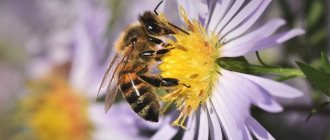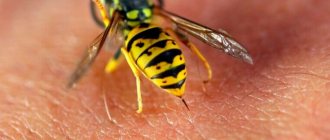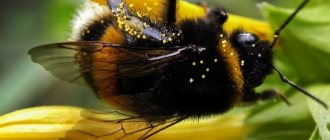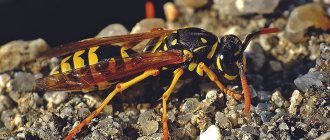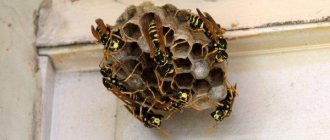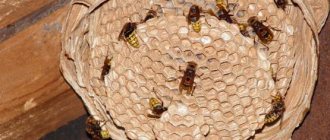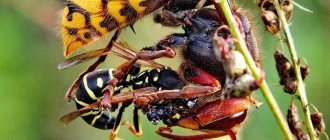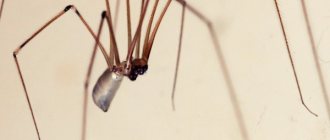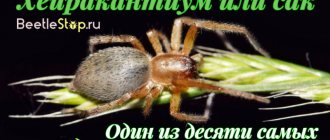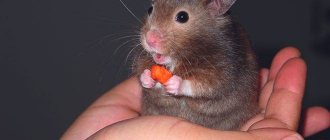A bee is a quite useful insect that produces wax, honey, and propolis. However, despite its benefits, many people are afraid of it. The reason for this is a bee sting.
Bees are not the only insects that bite humans. There are many others that harm humans, such as wasps, bumblebees, house ants, cockroaches and bedbugs. But today we will talk about bees.
To prevent undesirable consequences after a bee sting, you need to have an idea of how dangerous it is, what the body’s reactions may be and how to act in such a situation.
Why does a bee die after being stung?
The bee has a sting located at the end of its abdomen. It is used as a defense and releases poison when bitten. The sting can be used repeatedly to protect against other insects. But a bee can only bite an animal or a person once - then it dies.
Why does a bee die after a human attack? If a bee attacks a person or animal, then it is not able to pull the sting back, so the barbs on it get caught in the soft skin. To free itself, the bee makes sharp jerks. Having pulled out the sting, part of the intestine remains, causing the insect to die.
Why can't you kill a bee if it stings or attacks you?
If you kill a bee, its body releases a certain substance that acts as a military alarm: other bees will flock to you.
Prevention
To avoid bee stings, you need to follow simple recommendations:
- If a bee flies very close, you should not try to drive it away. It is important to remain calm and not make sudden movements until the insect flies away.
- Experts do not advise being afraid of bees. Many scientists claim that insects sense how adrenaline is produced.
- Don't wear bright clothes that attract bees.
- It is not recommended to use perfumes and deodorants that have strong odors. They attract insects.
- You should not walk barefoot on the grass.
Bee stings can pose a real danger to human health and life. Therefore, it is important to provide first aid to the victim in a timely manner. If allergy symptoms appear, a person must be immediately taken to a medical facility.
The danger of a bee sting
A bee sting is harmful and dangerous due to the composition of the substances included in it:
- Melitin is the basic toxin of the poison, destroys red blood cells, increases vascular permeability, releases substances that stimulate inflammation, disrupts metabolic interstitial processes, and causes muscle contractions.
- Apamin - acts on nerve cells, increases motor activity, and has a stimulating effect on spinal cells.
- Histamine protein - releases histamine from mast cells and is the main substance in allergic reactions.
- Histamine – causes pain, swelling, redness, dilates blood vessels.
- Hyaluronidase - spreads venom from the bite point to adjacent tissues.
- Phospholipase A - increases the inflammatory process and damages blood cells.
- Minimin is a highly active peptide.
When a bee stings, two reactions of the human body occur:
- normal (toxic)
- allergic (insect allergy)
The way a person reacts determines what first aid is provided. Depending on the amount of poison entering the body, reactions are divided into groups.
Reactions of the first type - ordinary - are of the following types:
- encephalitis
- malignant myasthenia gravis
- mononeuritis
Reactions of the second type - allergic - are especially harmful and have 3 degrees:
I degree of reaction and symptoms accompanying it:
- slight chills
- angioneurotic tumor (Quincke's edema)
- hives
- elevated body temperature
- nausea, vomiting
- headache
II degree of reaction (moderate severity) and its symptoms:
- heart rhythm disorder
- swelling of the mucous membranes
- spasms of the bronchial muscles
III degree of reaction (severe) and its symptoms:
Anaphylactic shock (without medical assistance, death is possible).
Harm and benefits of bee venom
It is believed that humans receive nutrients through insect secretions. Doctors call this process bee apitherapy. The poison has a complex composition:
- sulfur;
- manganese;
- stearins;
- amino acid enzymes;
- nitrogen;
- fructose;
- glucose;
- phosphorus;
- iodine;
- chlorine.
The set of substances in bee secretions is similar in composition to the components of a strong antibiotic. They retain their antibacterial effect throughout the duration of the poison's action, even after the death of the insect.
Interesting! Scientists noted that the secret can be used to create new drugs. The components of bee venom remain sterile for several days. The substance can be diluted to a ratio of 5000:1 without loss of benefit. Therefore, despite the tiny dose, it remains useful and effective for humans.
Read more about the benefits of bee venom for humans in this article.
Bee secretion has the following features:
- destroys E. coli;
- kills staphylococci, streptococci;
- diphtheria pathogens will be destroyed from exposure;
- bacteria and viruses die.
The mechanism of action of the poison is not lost even when water is heated to the boiling point. It has a strengthening effect on the human body, increasing immunity. It also dilates blood vessels and enhances the diuretic effect. When blood thins, blood pressure normalizes and hemoglobin levels increase. In some medicines, bee venom is needed to reduce fever in children and adults and improve metabolism.
Despite its benefits, bee venom has one significant drawback. It is contraindicated for people diagnosed with individual intolerance. In such cases, you don’t have to be afraid of only males, since drones don’t bite. Worker bees sting and have a long nose. Males cannot provide themselves with food; they live only at the expense of the worker colony.
Negative effects of bee vinegars:
| Power of defeat | Manifestation | Complications |
| Lightweight | Destruction of red blood cells | Heavy bleeding |
| Weak, average | Disturbance of the composition of nerve cells | Atrophic effects on the central nervous system |
| Strong | Weakness, vomiting, rash, loss of consciousness | Respiratory arrest, death |
Bee stings pose the greatest danger to children. Children of preschool age from 2 to 6-7 years remain at risk. Most often, bites occur in the mucous membranes: lips, eyes, nose. Painful insect stings can cause the membranes to expand. For example, a bite to the tongue is accompanied by swelling of the organ, after which the airways become blocked. If emergency medical care is not provided, asphyxia occurs.
First aid for a bite
Help with a bee sting should be carried out in the following order.
Removing the sting
After a bee sting, you must carefully remove the sting (without touching the sac of poison) remaining in the skin. It's best to use tweezers here. You must first treat the instrument with alcohol or a disinfectant.
You must not squeeze out the sting, otherwise the poison will spread throughout the body faster!
Neutralization of bee venom
Neutralize the poison with a soap solution. Why soap solution? Bee venom has an acidic pH, so it can be neutralized with an alkaline solution, in this case soap.
Disinfection
Treat the arm, leg, or other bite site with hydrogen peroxide, a solution of ammonia (it can also relieve swelling) or potassium permanganate, or alcohol tincture of calendula.
A swelling from a wasp sting can be removed with solutions of soda or salt. One of the main signs of a bedbug bite is a puncture mark. You will find a description of other symptoms in this article.
The Colorado potato beetle is a serious pest of potatoes, tomatoes and eggplants. Read the link for a detailed description of the insect.
Elimination of pain, itching, swelling
To relieve pain, use a cold compress (ice wrapped in a towel, for example). There is great benefit from medications and ointments with an antihistamine effect. For example, “Suprastin”, “Diphenhydramine”, “Fenistil”, etc. They can relieve symptoms.
It is also important to know that you should not scratch the tumor after a bee sting, as this contributes to the faster spread of poison throughout the body.
Main symptoms of a bite
Bee sting syndrome occurs within ten minutes. The initial reaction may be mild, with symptoms remaining mild for up to several hours. Those who are susceptible to allergic reactions experience:
- severe dry mouth;
- redness in the bite area, accompanied by acute throbbing pain;
- swelling, in the center of which a white dot forms.
As a result of a bee sting, a person experiences discomfort and itching. A rash appears, similar in appearance to hives. Severe symptoms include nausea and vomiting. Acute side effects manifest themselves in the form of cough, asthmatic attack.
The most unpleasant symptom of a bee sting is anaphylaxis. This is an allergy that occurs in an acute form and can pose a threat to human life. To distinguish it from an asthma attack, you need to pay attention to symptoms such as:
- Swelling of soft tissues manifests itself only as a complication and cannot be a consequence of the onset of an asthmatic attack.
- A drop in pressure - due to the fact that a person is suffocating, the lack of oxygen causes disturbances in the functioning of the circulatory system. In the case of asthma, respiration does not stop, although it is superficial.
- Loss of consciousness – fainting occurs within 15-17 minutes, however, the person does not need to be revived.
If symptoms begin to appear sharply and the condition worsens, you should immediately remove the sting and provide medical assistance. At the rehabilitation center, skin tests are taken and the level of presence of specific IgE antibodies is measured.
What to do if the victim has an insect allergy
Particularly harmful are cases where there is an allergy to a bee sting.
Help with a bee sting and what you can do:
- Call the doctors
- Remove sting
- Treat the wound with an antiseptic and apply a cold compress (the cold can be kept for 4 hours, no more) to prevent swelling
- Take an antihistamine
Many people believe that it is enough for an allergic person to administer epinephrine and the reaction will stop. But there are times when this is not enough and the knowledge of a doctor is required. Do not rely only on the case of “As usual” and if you are allergic to a bee sting, call an ambulance.
Help provided by doctors:
- The first thing doctors will do is to carry out a circular infiltration blockade with novocaine and use forced diuresis with alkalization of the blood
- Administration of calcium chloride or gluconate, ascorbic acid, prednisolone and antihistamines
- Hospitalization for subsequent inpatient treatment
Tests and diagnostics
Bee sting photo
It is usually possible to determine that a person has been bitten by a bee visually. But if we are talking about severe allergic reactions, then you have to call emergency help, whose doctors will examine you and make a preliminary diagnosis.
If necessary, if a person develops severe reactions, additional examinations are carried out.
- Physical blood pressure are measured . The doctor examines the skin to determine whether there are signs of allergies . Listening to the lungs may be performed.
- Laboratory - a general blood test is performed to determine signs of the inflammatory process
- Hardware - its use is advisable only in the development of pronounced systemic manifestations. Ultrasound, radiography, and ECG are used.
Folk remedies for treating a bite
- Aspirin and activated carbon are excellent absorbents of various poisons. When combined with aspirin, it can treat pain and itching. Dissolve one tablet in a glass of water and apply cotton wool soaked in this solution to the desired location.
- Parsley - this plant produces a good anti-inflammatory effect and is beneficial. Apply parsley leaves brewed in boiling water or crushed to the stung hand, leg, etc. The plant treats redness, swelling and pain. You can add plantain leaves to parsley, which help speed up wound healing.
- Olive oil - can relieve redness and irritation. Unsaturated fatty acids in the oil have a regenerating and nourishing effect on the skin.
- Onion juice contains substances that bind the components of bee venom. Helps relieve pain, redness and reduce swelling.
- Aloe has numerous medicinal properties. The diluted juice of the plant is used as a compress. Aloe treats itching, hives, swelling.
Never apply soil when bitten, as traditional medicine advises! This will not relieve pain and may lead to infection.
Why are stinging insects dangerous?
In this matter, it is important to understand that the danger is not the insect bite itself, but the poison that it injects under the skin through its sting. Since a bee's sting is intended for its own protection, it is better not to tease the insect. Do not wave your arms near it, do not try to catch or “slam” it if a bee lands on your body.
While for most people the consequences of a bite quickly disappear, for some people it poses a mortal danger. The poison that gets under the skin contains a lot of different biologically active substances (proteins) that the human body does not accept. An allergic reaction appears. It can cause headaches, itching, swelling of the extremities, general malaise and even seizures. With a pronounced reaction, a person may even lose consciousness. For those who suffer from high sensitivity to bee venom, it can cause angioedema or anaphylactic shock.
For those who do not have allergies, such consequences are not terrible. Most often, the victim only feels a burning sensation and itching at the site of the bite. A slight swelling may appear, which will subside after a couple of days.
But multiple bee stings will pose a danger even to completely healthy people. A large amount of poison immediately enters the body, which causes intoxication. Vomiting, chills and fever begin. Cases have been recorded where multiple bee stings have resulted in death.
Why remove the sting and how to remove it?
Because the bee stinger has barbs, once it has entered the skin, it is not so easy to pull it out. The insect does not have enough strength for this, and it flies away, leaving behind not only its weapon, but also a reservoir of poison, and sometimes part of the abdomen. This is why a bee dies after stinging. As long as the sting remains in the human body, the poison continues to enter the blood. To stop this process, the first thing you need to do if you are stung by a bee is to remove the sting.
Removing the sting
Bumblebee
The bumblebee and the bee are close relatives. Like bees, bumblebees are non-confrontational and attack only in exceptional cases, if there is no other option left. A bumblebee, unlike a bee, can sting many times, because bites of the insect itself do not cause any harm. But only females sting; males have genitals instead of stings, and their main purpose is to fertilize the uterus.
By the way, bumblebees and wasps are often at odds. Wasps rob bumblebee nests, eating supplies.
If we compare the stings produced by bumblebees and bees, the latter sting more painfully, and their venom is more toxic, besides, the bee's sting will have to be pulled out, but the bumblebee does not leave a sting.
On its own initiative, a bumblebee can bite in two situations:
- if the person's clothes are blue. For some reason, the blue color seems to be a threat to insects, and the bumblebee may behave inappropriately.
- if a person smells strongly of alcohol, tobacco or perfume. This could also be a reason for an attack.
Diet
Hypoallergenic diet
- Efficacy: therapeutic effect after 21-40 days
- Timing: constantly
- Cost of products: 1300-1400 rubles. in Week
If a person is stung by an insect, he should be sure to consume a sufficient amount of fluid. You need to drink clean water, as well as weak tea, fruit drinks, and compotes.
Nutrition should be healthy and nutritious. If a person has a tendency to allergies, foods that provoke allergic reactions should be excluded from the menu.
Where can you find insects
© Getty Images Pro
Bees
live in large families in hives. They are most often found near flowers, but they also like to live in hollow trees, abandoned rodent burrows, wooden objects and roofs.
bumblebees
They live in small families, usually on the ground or in empty bird nests.
Wasps
They live in families, usually on the ground or under roof space, and their nests can often be found in places such as gutters, bushes and areas along fences. Wasps love meat, so if you barbecue, they may fly onto the meat.
Hornets nests
can be on trees, bushes, hanging from eaves and even poles. Since they are a type of wasp, they also love meat.
How to avoid bee stings
When going out into nature where there may be bees, you should learn the following:
- Clothes should not be bright. These colors attract bees and other flying insects.
- There is no need to overindulge in sweets. If there are any, then very carefully. Bees and wasps love to flock to sweets, and there is a danger of being bitten in one of the most dangerous areas - the lower part of the face. Bees are also attracted to pungent odors, such as perfume or alcohol.
- If the bees do flock together, you need to remain motionless. Waving your arms will alert and anger the insects. There is also no need to be afraid, as bees sense the adrenaline released and become more aggressive. You just need to make sure that insects don’t fly under your clothes (in nature you should generally wear covered fabric), and if they land too brazenly, carefully blow them away.
How to relieve swelling from a bee sting on the second day
If the swelling has not been treated for more than a day, then it will be a little more difficult to quickly get rid of it. Here you will have to use antiallergic drugs in the form of ointments and tablets. Traditional recipes - baths, lotions and the like will also not hurt, but you need to make sure that they do not cause more harm.
Drug treatment
Medicines can be prescribed both local and systemic. They are prescribed based on the presence of a generalized allergic reaction. Doctors prescribe the following types of medications:
- Glucocorticoids.
- Antihistamine tablets.
- Parenteral glucocorticoids.
